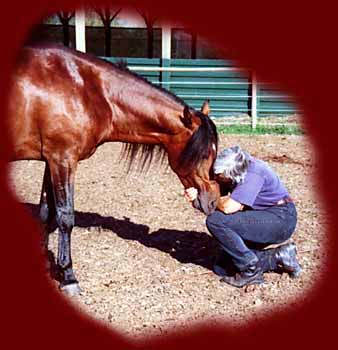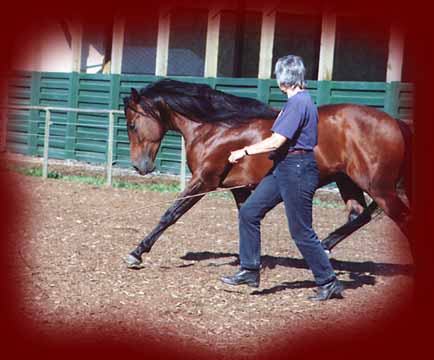 I like to nurture a two-way feel, mutual trust and affection with a horse before I ever put a foot in the stirrup. I want to establish a system of communication that is consistent, clear and goes both ways. And most of all, I want it to be fun...for both of us. When I start out with the idea that feel needs to be built in from the very beginning, there is seldom any need to be physically forceful with a horse, and by the time I start riding him I have a partner who responds happily to the lightest of requests. |
 A moment
of quiet communication |
Before we reach the riding stage, I prefer to spend considerable time on ground handling, establishing an introduction to some of the things that we will be doing when I am on his back. By the time I am ready to climb into the saddle for the first time, he already understands the concepts behind yielding to pressure in many of its forms, he understands various verbal cues coupled with body cues for lengthening and shortening and elevating stride, he has a whole catalogue of building blocks that in various combinations will make up many of the movements I will request of him from the saddle. Thus equipped, a young horse can embark on his undersaddle training with confidence and enthusiasm, with minimal tension to complicate progress, while allowing full expression of his movement to be encouraged. |
|
Summer 2000 During ground work the whip is used strictly as an extension of my arm to offer suggestions or guidance to the horse. I do not use it to hit the horse, but may touch him gently with it to draw attention to an area of his body. Here Oporto's focus is on me and the positioning of the lash of the whip, which is out in front of him encouraging him to think forward and reach forward in his trot. If instead I wished him to elevate his stride more, the tip of the whip would be placed higher. |
|
Email: rafalet2ride@yahoo.ca | Home | Riding
Theory | Lusitano history |
Lusitano characteristics | Last updated October 13, 2000 Changes and additions are ongoing- please check back frequently © 2000/2006 K. Woollatt. All rights reserved. |
|


.jpg)